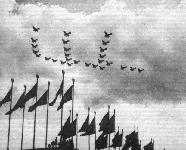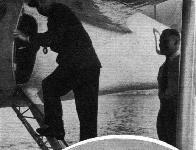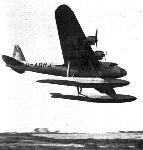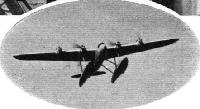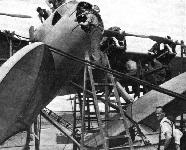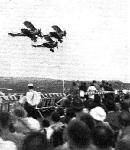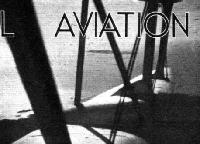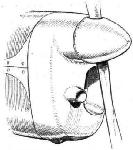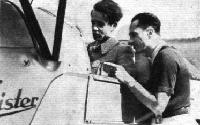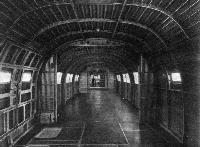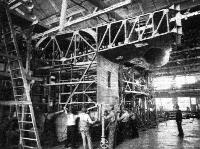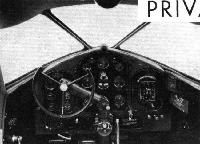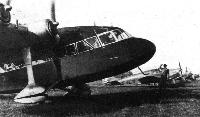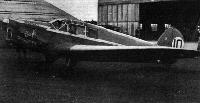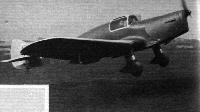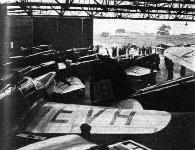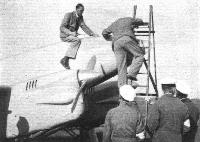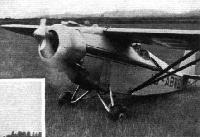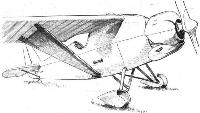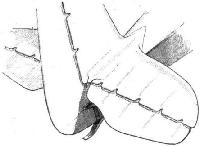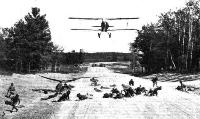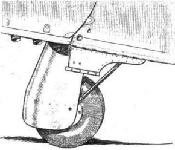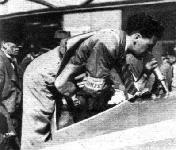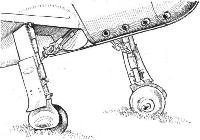Фотографии
-
GERMANY'S WAR GAME: Troops taking cover beneath the wing of a Messerschmitt Me. 109 fighter during the recent mock air raid on Berlin, for which 7,000 public shelters were built. Details of the Me. 109 are well worth study.
Самолёты на фотографии: Messerschmitt Bf.109 / Bf.109B / Bf.109C / Bf.109D - Германия - 1935
-
A formation of Heinkel fighters during the military display which concluded the Nazi Congress at Nurnberg.
Самолёты на фотографии: Heinkel He-51 - Германия - 1933
-
EXPOSED IN PARIS: A mock-up Morane fighter leads the racing Caudron C-460, a winner at last year's U.S. National Air Races, through one of the halls in the Salon D'Aviation. Whatever the criticisms aimed at some of the Exhibition interiors, there can be no quarrel with this one.
Самолёты на фотографии: Caudron C.360 / C.450 / C.460 / C.560 - Франция - 1933Morane-Saulnier MS.405/406/410C1 - Франция - 1935
-
On the whole, Continental installations of liquid-cooled engines cannot compare with Rolls-Royce practice. This view shows the Hispano X "cannon" engine in the Dewoitine D.500 fighter bought by the Air Ministry.
Самолёты на фотографии: Dewoitine D.500 / D.510 - Франция - 1932
-
"Echelon stepped up" is a most tricky formation, but in the picture the young pilots of No. 63 (Bomber) Squadron are doing very well.
Самолёты на фотографии: Fairey Battle - Великобритания - 1936
-
A flight of Fairey Battles in formation. This picture shows the plan view of the machine as it would appear to diving fighters in air exercises.
Самолёты на фотографии: Fairey Battle - Великобритания - 1936
-
Shadow-shading helps to make an aeroplane inconspicuous when seen from above with the earth as a background, but against a white cloud the machines stand out vividly.
Самолёты на фотографии: Fairey Battle - Великобритания - 1936
-
The re-formed No. 63 Squadron. Squadron Leader V. S. Parker, D.F.C. A.F.C., the Commanding Officer, is in the centre.
Самолёты на фотографии: Fairey Battle - Великобритания - 1936
-
With its wheels retracted and almost entirely concealed, the Battle is as clean as any aeroplane in the skies. Its top speed is given by the manufacturers as 257 m.p.h.
Самолёты на фотографии: Fairey Battle - Великобритания - 1936
-
The Fairey Battles are lined up on Upwood aerodrome.
Самолёты на фотографии: Fairey Battle - Великобритания - 1936
-
Регистрационный номер: G-ADHJ [10], G-ADHK [2] EIGHT-ENGINED BIPLANE: This composite picture of the Short-Mayo gives an excellent idea of the relative sizes of the two components and of the appearance of the assembly as a whole before it is amoebically split into two. Mercury, the upper component, made flying trials early this week.
Самолёты на фотографии: Short Mayo Composite (S.20 Mercury and S.21 Maia) - Великобритания - 1938
-
Регистрационный номер: G-ADHJ [10], G-ADHK [2] "MAIA" MEETS "MERCURY": Following the tradition of "happy events," the lusty baby Mercury, upper component of the Short-Mayo Composite aircraft, was brought along to her mother-ship, Maia, last week.
Самолёты на фотографии: Short Mayo Composite (S.20 Mercury and S.21 Maia) - Великобритания - 1938
-
Регистрационный номер: G-ADHJ [10] Самолёты на фотографии: Short Mayo Composite (S.20 Mercury and S.21 Maia) - Великобритания - 1938
-
Регистрационный номер: G-ADHJ [10] Just before Mercury's third flight: Mr. J. Lankester Parker going on board to give his demonstration. Mr. H. L. Piper, who will fly the machine during the next series of tests and during the actual separation, watches from his perch on one of the floats.
Самолёты на фотографии: Short Mayo Composite (S.20 Mercury and S.21 Maia) - Великобритания - 1938
-
Регистрационный номер: G-ADHJ [10] A perfect landing: Without trailing-edge flaps the speed is not excessive, even with the load carried when this picture was taken.
Самолёты на фотографии: Short Mayo Composite (S.20 Mercury and S.21 Maia) - Великобритания - 1938
-
Регистрационный номер: G-ADHJ [10] In spite of its large floats, Mercury appears to have a top speed of considerably more than 200 m.p.h.
Самолёты на фотографии: Short Mayo Composite (S.20 Mercury and S.21 Maia) - Великобритания - 1938
-
Регистрационный номер: G-ADHJ [10] The graceful lines are well brought out in the photograph of the machine flying overhead.
Самолёты на фотографии: Short Mayo Composite (S.20 Mercury and S.21 Maia) - Великобритания - 1938
-
Регистрационный номер: G-ADHJ [10] The picture shows the very small frontal area. Note how little the Napier-Halford engines project.
Самолёты на фотографии: Short Mayo Composite (S.20 Mercury and S.21 Maia) - Великобритания - 1938
-
Регистрационный номер: G-ADHJ [10] Самолёты на фотографии: Short Mayo Composite (S.20 Mercury and S.21 Maia) - Великобритания - 1938
-
Регистрационный номер: G-ADHJ [10] Самолёты на фотографии: Short Mayo Composite (S.20 Mercury and S.21 Maia) - Великобритания - 1938
-
The Hawker "Hart" with Rolls-Royce "F" type engine. This machine has been fitted with steam cooling. Note the condensers along the leading edges of the upper and lower planes.
Самолёты на фотографии: Hawker Hart - Великобритания - 1928
-
Up and down: In the air, the B.A. Eagle being demonstrated by Mr. Bay; on the ground, the Hawk Speed Six and the new Wicko.
Самолёты на фотографии: British Klemm BK-1 Eagle - Великобритания - 1934Foster Wikner Wicko - Великобритания - 1936Miles Hawk / M.2 - Великобритания - 1932
-
Lord Londonderry tries out Flt. Lt. "Shell" Bentley's Hawk Major.
Самолёты на фотографии: Miles Hawk / M.2 - Великобритания - 1932
-
Самолёты на фотографии: Miles Hawk / M.2 - Великобритания - 1932
-
Регистрационный номер: G-ADLC Самолёты на фотографии: Miles Falcon M.3 / Hawcon M.6 - Великобритания - 1934
-
Регистрационный номер: L5916 Самолёты на фотографии: Miles Magister / M.14 - Великобритания - 1937
-
Mr. Miles has adopted this "leg"-type undercarriage for the Magister.
Самолёты на фотографии: Miles Magister / M.14 - Великобритания - 1937
-
Against the Ohio sky: Three Boeing fighters of the U.S. Army Air Corps which gave an aerobatic at the National Air Races.
Самолёты на фотографии: Boeing F4B / P-12 - США - 1928
-
ANGLO-CANADIAN-AMERICAN: One of two Northrop Delta cabin floatplanes built under licence by the Canadian Vickers firm for the Royal Canadian Air Force. The engine is a 750 h.p. Wright Cyclone F.
Самолёты на фотографии: Northrop Delta - США - 1933
-
Belgian Air Force officers called at Hucclecote last week to collect nine Gloster Gladiators, part of a contract. Their formation work - the photographs were taken only a few minutes after they had entered the machines for the first time - is testimony to men and machines.
Самолёты на фотографии: Gloster Gladiator - Великобритания - 1934
-
Group, left to right : Adj. Pessendorffer, Adj. Bochmann, Adj. Piercot, Mr. N. Daunt, Adj. Wegria, Flt. Lt. P. E. G. Sayer, Adj. Cluytens, Lieut. Elroy, 2nd. Lieut. Creteur, F/O. Maurice Summers, Capt. Le Grand, Mr. J. Hindmarsh, M. Vanderghote.
Самолёты на фотографии: Gloster Gladiator - Великобритания - 1934
-
Самолёты на фотографии: Gloster Gladiator - Великобритания - 1934
-
Frank Fuller's new Seversky in action. This machine is a racing development of a standard pursuit type ordered in quantity by the U.S. Army Air Corps to replace the obsolescent Boeings.
Самолёты на фотографии: Seversky P-35 - США - 1936
-
Регистрационный номер: R70Y Frank Fuller's new Seversky at rest. This machine is a racing development of a standard pursuit type ordered in quantity by the U.S. Army Air Corps to replace the obsolescent Boeings.
Самолёты на фотографии: Seversky P-35 - США - 1936
-
Регистрационный номер: D-EHNE, YL-ABG The two leading machines, the Klemm in the foreground and the V.E.F. on the left. Two of the four Gauntlets at the meeting may be distinguished in the background.
Самолёты на фотографии: Gloster Gauntlet - Великобритания - 1929Irbitis, VEF I-11 / I-12 / I-17 - Латвия - 1936Klemm Kl.35 / Kl.106 - Германия - 1935
-
The three Gauntlets of No. 111 (F) Sq. are concluding one of their two shows.
Самолёты на фотографии: Gloster Gauntlet - Великобритания - 1929
-
Sea and cloud: A pleasing impression ol the Singapore III's ot Nos. 209 and 210 (G.R.) Squadrons leaving for the Mediterranean to join the anti-piracy patrol.
Самолёты на фотографии: Short Singapore III / S.19 - Великобритания - 1934
-
SALT IN THE AIR: A Short Singapore III (four Rolls-Royce Kestrels) touches down alongside destroyers in Portland Harbour. The Singapore is probably the largest military flying boat in service in the world
Самолёты на фотографии: Short Singapore III / S.19 - Великобритания - 1934
-
MALTESE CAMEO: A Fairey Swordfish torpedo spotter reconnaissance floatplane (690/750 h.p. Bristol Pegasus III) from the Courageous landing in Valetta Harbour, Malta.
Самолёты на фотографии: Fairey Swordfish - Великобритания - 1934
-
Регистрационный номер: K3583 TROOPER-BOMBER: The Bristol Bombay (Type 130) bomber-transport which recently conveyed British Staff Officers to the German manoeuvres. The Bombay is being built in quantity by Short and Harland. With two Bristol Pegasus Xs (960 h.p. max.) the performance is a revelation.
This view of the prototype Bombay shows well the wide-track undercarriage and excellent view for the forward gunner.Самолёты на фотографии: Bristol Bombay / Type 130 - Великобритания - 1935
-
JERSEY EXPRESS: The Island of Alderney passes beyond the wing-tip of a homeward-bound Jersey Airways' D.H.86, the crews of which nowadays have permission to cut ths corner of the French coast, which can be seen in the left-hand corner.
Самолёты на фотографии: De Havilland Express Air Liner / D.H.86 - Великобритания - 1934
-
"... a quick inspection of the new control tower and buildings at Liverpool ..." The A.S.T. Dragonfly and Vega Gull on the tarmac at Speke.
Самолёты на фотографии: De Havilland Dragonfly / D.H.90 - Великобритания - 1935Percival Vega Gull / K.1 - Великобритания - 1935
-
An advanced Kestrel XVI installation in the new Miles trainer/general-purpose military monoplane. The coolant is ethylene glycol.
Самолёты на фотографии: Miles Kestrel M.9 / Master I M.9A - Великобритания - 1937
-
Регистрационный номер: G-AEKL [3] ZERO HOUR APPROACHES: The scene at Hatfield before the start of the King's Cup Race eliminating contest last Friday. Nearest the camera is Charles Gardner's blue 1936 model Percival Mew Gull which won the final at an average speed of 233.7 rn.p.h.
Самолёты на фотографии: Percival Mew Gull - Великобритания - 1934
-
Регистрационный номер: G-AEKL [3] Gardner's victorious Mew Gull being led in after the finish at Hatfield.
Самолёты на фотографии: Percival Mew Gull - Великобритания - 1934
-
Регистрационный номер: G-AEKL [3] Gardner's winning Mew Gull (Gipsy Six II).
Самолёты на фотографии: Percival Mew Gull - Великобритания - 1934
-
Регистрационный номер: G-AEXF, ZS-AHM Three Percival Mew Gulls - two with Series II Gipsy Six engines - are entered. This view is of Alex Henshaw's machine with Series I engine.
Самолёты на фотографии: Percival Mew Gull - Великобритания - 1934
-
Регистрационный номер: G-AFAA Capt. Percival's Mew Gull, which finished third in the final and which made the fastest actual speed on both days.
Самолёты на фотографии: Percival Mew Gull - Великобритания - 1934
-
Family affair: Miss Pearl Henshaw, "Pop" and Alex, clean down their Mew Gull at Baldonnell.
Самолёты на фотографии: Percival Mew Gull - Великобритания - 1934
-
Mr. Gardner, photographed at the start.
Самолёты на фотографии: Percival Mew Gull - Великобритания - 1934
-
The instruments and controls of Gardner's Mew Gull. The majority of instruments, unless otherwise indicated, are Smith's :- (1) Reid and Sigrist turn-and-bank indicator, (2) Airspeed indicator. (3) Altimeter - another is concealed by the card at the foot of the panel. (4) and (5) Air intake temperature switch and indicator. (6) Fuel gauge - another is hidden on the extreme left of the panel. (7) Clock. (8) Air intake and flame-trap control. (9) Airscrew pitch control. (10) Tail trimmer. (11) Compass. (12) Stop watches (13) Throttle and altitude controls. (14) Ignition switches. (15) Oil pressure. (16) Sperry directional gyro. (17) Boost pressure gauge. (18) Engine rev. indicator. The flap control, not visible in this view, is below the throttle controls.
Самолёты на фотографии: Percival Mew Gull - Великобритания - 1934
-
The air intake in the cowling of Capt. Percival's Mew Gull, near the airscrew, gives a boosting effect.
Самолёты на фотографии: Percival Mew Gull - Великобритания - 1934
-
Venturi tube on a swivelling mounting on Henshaw's Mew Gull.
Самолёты на фотографии: Percival Mew Gull - Великобритания - 1934
-
Самолёты на фотографии: Percival Mew Gull - Великобритания - 1934
-
Самолёты на фотографии: Percival Vega Gull / K.1 - Великобритания - 1935
-
IMPRESSIONISM: An effective portrait of Air Hire's new v.p. Vega Gull at Heston. This machine has a good deal of special equipment for night operations.
Самолёты на фотографии: Percival Vega Gull / K.1 - Великобритания - 1935
-
In spite of the large aggregate amount of sea-crossing, very few competitors took the precaution of wearing life-saving jackets. Derek Schreiber (right) and Flt.-Lt. Peel, his navigator, were among the exceptions.
Самолёты на фотографии: Percival Vega Gull / K.1 - Великобритания - 1935
-
Two wide doors simplify, as far as possible, the business of entry into the front or rear seats of the Vega Gull.
Самолёты на фотографии: Percival Vega Gull / K.1 - Великобритания - 1935
-
The Woolsington wind-sock gives some indication of the strength of the wind at the Newcastle control. The machine coming in is the Vega Gull flown by Miss Dillon and Capt. Neville Stack.
Самолёты на фотографии: Percival Vega Gull / K.1 - Великобритания - 1935
-
All the Vega Gulls except one, as shown here, will have Series II Gipsy Sixes with D.H. v.p. airscrews.
Самолёты на фотографии: Percival Vega Gull / K.1 - Великобритания - 1935
-
The instruments and engine controls of the v.p. Vega Gull. On the extreme right is the landing and navigation light switchboard, while on the left is the useful left-hand additional throttle lever. At the base of the dashboard can be seen (on the left side) the fuel pump, airscrew pitch and intake controls, with (behind the dua! stick) the flooding control. The gauges for the four fuel tanks are on the right of the dash, and the boost gauge is in the centre at the top.
Самолёты на фотографии: Percival Vega Gull / K.1 - Великобритания - 1935
-
Регистрационный номер: G-ADUZ CYGNUS plays the lead - an attractive "still" from Paul Rotha's documentary film, The Future's in the Air, now being completed by the Strand Film Co. The picture deals with our Empire airways.
Самолёты на фотографии: Short Empire / S.23 - Великобритания - 1936
-
Регистрационный номер: G-ADNO The T.K.2 provides Mr. G. de Havilland with a little "g" at the aerodrome turn
Самолёты на фотографии: De Havilland Technical School T.K.2 - Великобритания - 1935
-
Регистрационный номер: G-AENU The Cirrus Major 150 is installed in the new high-wing Wicko.
Самолёты на фотографии: Foster Wikner Wicko - Великобритания - 1936
-
MODERN AIRPORT: A view of the terminal building - reminiscent in general appearance of that at the unlucky Gatwick - of the new Budapest Airport taken on the day before the official opening, with M. Budaor's Bucker Jungmann in the foreground. The building must be one of the most beautifully arranged and decorated at any airport in the world.
Самолёты на фотографии: Bucker Bu.131 Jungmann - Германия - 1934
-
Count von Hagenburg (in cockpit) borrowed an aerobatic Bucker from Capt. Alex. Papana.
Самолёты на фотографии: Bucker Bu.133 Jungmeister - Германия - 1935
-
Beating the band: Herr Paul Forster (F. W. Stieglitz) concludes his performance with a not-too-emotioning inverted fly-past. We are slowly becoming accustomed to that sort of thing.
Самолёты на фотографии: Focke-Wulf FW.44 Steiglitz - Германия - 1932
-
An impression of Herr Emil Kropf's F. W. Stosser. Close inspection may show that the pilot is holding lots of top rudder and left aileron; anyway, the machine is not going in the direction in which it is pointing.
Самолёты на фотографии: Focke-Wulf FW.56 Stosser - Германия - 1933
-
Регистрационный номер: D-AJIE The new Heinkel is distinctly reminiscent of the He.111 twin-engined model.
Самолёты на фотографии: Heinkel He-116 - Германия - 1937
-
Регистрационный номер: D-AALU 'THE DESSAU GIANT' is a free translation of the name of the prototype Junkers Ju.90. The installation of the inverted-vee Mercedes can be gathered from this view
Самолёты на фотографии: Junkers Ju.90 - Германия - 1937
-
"THESE COMMODIOUS UNFURNISHED PREMISES." The house-agents' jargon seems nicely applicable to the truly startling interior of the prototype Junkers Ju.90 airliner, which is now undergoing its initial flying trials. Divided into five compartments, the cabin will accomodate forty passengers, and there will be several baggage, mail and lavatory divisions.
The unobstructed interior, looking forward.Самолёты на фотографии: Junkers Ju.90 - Германия - 1937
-
The Klemm 35, which, flown by Herr Clausen, won the race, rounding the aerodrome turn. He is about to overtake Mr. Du Port's Moth Major.
Самолёты на фотографии: De Havilland Moth Major / D.H.60GIII - Великобритания - 1932Klemm Kl.35 / Kl.106 - Германия - 1935
-
Herr Clausen is being congratulated by Mrs. W. E. Davis, who entered the machine which finished third.
Самолёты на фотографии: Klemm Kl.35 / Kl.106 - Германия - 1935
-
A CLIPPER TAKES SHAPE: The first of the Boeing Clippers, which will weigh twice as much as a Short Empire boat, is being assembled and should be flying in a few months. This view shows the junction of wing and hull.
Самолёты на фотографии: Boeing Boeing 314 Clipper - США - 1938
-
"STYLING," as the Americans call decorative schemes, is a feature of the latest Fairchild 24, with 150 h.p. in-line Ranger engine. A luxury interior offers a choice of five upholstery colours, and fourteen colour combinations are available for the exterior. Cruising at 123 m.p.h., it carries three, and one of the well-established Warner-radial-engined models is available as a four-seater. Malcolm and Farquharson, of Heston, state that these machines may appear on the British market.
Самолёты на фотографии: Fairchild C-61 Forwarder / Model 24 / Argus - США - 1932
-
AS IT SHOULD BE: We in this country can certainly learn something from America when it comes to making instrument boards look as if they are designed from the start and for the job. This is the panel of the Fairchild "45" low-wing luxury private-owner type (handled by Malcolm and Farquharson of Heston) fitted with the new Fairchild radio compass. At the top of the centre panel is the indicator, on the right is the remote control panel and (lower corner) the rotator control. The majority of the other instruments speak for themselves. The "45" carries five people at a cruising speed of 173 m.p.h.
Самолёты на фотографии: Fairchild Model 45 - США - 1935
-
U.S. PILOTS GET TOGETHER: A trio of Grumman fighters from an American aircraft-carrier dress by the left during manoeuvres. These Grummans have 700 h.p. Pratt and Whitney Twin Wasp Junior engines and are the fastest machines of their class in service.
Самолёты на фотографии: Grumman F2F - США - 1933
-
The Gwinn Aircar typify the present American trend toward three-wheeled undercarriages. This machine is offered as a practical private-owner type. A Pobjoy powers the Gwinn.
Самолёты на фотографии: Gwinn Aircar - США - 1936
-
Регистрационный номер: R189M The American Republic 2-PA as supplied to Sweden. It has heavy fixed-gun armament and one free gun on a manually-operated mounting. The rear cockpit fairing is retractable.
Самолёты на фотографии: Seversky SEV-2PA / AT-12 - США - 1937
-
View of the new Seversky two-seater fighter developed for the export market, showing the installation of the free Browning gun. The engine is an 850 h.p. Cyclone G. Major. Alexander de Seversky is seen "up front."
Самолёты на фотографии: Seversky SEV-2PA / AT-12 - США - 1937
-
Самолёты на фотографии: Sikorsky PBS / VS-44 Excalibur - США - 1937
-
Самолёты на фотографии: Sikorsky PBS / VS-44 Excalibur - США - 1937
-
The new Sikorsky is much more eyeable than the S-42 model, due not only to its greater aerodynamic cleanness but to the shape of the wing and hull.
Самолёты на фотографии: Sikorsky PBS / VS-44 Excalibur - США - 1937
-
Регистрационный номер: G-AEXW BUENOS FAKING. The Brooklands clubhouse after Warner Bros, had adapted it to film requirements as a Spanish Airport Building. The windsock must be an international one!
Самолёты на фотографии: Stinson Reliant - США - 1933
-
"... which, in view of age, type and original cost, was in the best condition."
Самолёты на фотографии: Stinson Reliant - США - 1933
-
The Waco Model N typify the present American trend toward three-wheeled undercarriages. This machine is offered as a practical private-owner type, the Waco being regarded as an addition to the standard range, which might indicate that the manufacturers intend to sound - public opinion before standardising the tricycle gear. The Waco - a four-seater - has one of the new Jacobs radials It seems that there is scarcely an American manufacturer who is not designing or building machines with a nose wheel.
Самолёты на фотографии: WACO N Series - США - 1937
-
The Waterman Arrowbile typify the present American trend toward three-wheeled undercarriages. This machine is offered as a practical private-owner type. The Waterman is being handled by the Studebaker concern and mounts the four-in-line Menasco.
Самолёты на фотографии: Waterman Arrowbile / W-5 - США - 1937
-
Самолёты на фотографии: De Havilland Dragon / D.H.84 - Великобритания - 1932
-
Mr. Piper in the Short Scion Senior entertains the Wilmington crowd.
Самолёты на фотографии: Short Scion Senior / S.22 - Великобритания - 1935
-
Регистрационный номер: G-AECU, HK868 The Short Scion Senior (four Pobjoy Niagaras) is shown as a landplane.
Самолёты на фотографии: Short Scion Senior / S.22 - Великобритания - 1935
-
Регистрационный номер: G-AEZO A Triton among the minnows: Piper's Short Scion Senior ready to leave the line on Friday. The next machine is Brig.-Gen. Lewin's Miles Whitney Straight, which finished second.
Самолёты на фотографии: Miles Whitney Straight / M.11 - Великобритания - 1936Short Scion Senior / S.22 - Великобритания - 1935
-
The B.A. Eagle (Gipsy Major).
Самолёты на фотографии: British Klemm BK-1 Eagle - Великобритания - 1934
-
Scarborough scars: Capt. W. L. Hope was only one of several competitors who bore visible evidence at Dublin of the bumping they received on the stretch up the North-East coast.
Самолёты на фотографии: British Klemm BK-1 Eagle - Великобритания - 1934
-
Самолёты на фотографии: Miles Whitney Straight / M.11 - Великобритания - 1936
-
"I was beginning to realise that I might be in the running for a place, provided the following wind did not help the two Miles Whitney Straights too much."
Самолёты на фотографии: Miles Whitney Straight / M.11 - Великобритания - 1936
-
Регистрационный номер: G-AEVH September in the Rain: The King's Cup machines were wheeled into the De Havilland erecting shops to afford shelter to the associated humanity during Thursday's downpour.
Самолёты на фотографии: Miles Whitney Straight / M.11 - Великобритания - 1936
-
A handicapper handicapped: Capt. Dancy, suffering from an injured foot, does a little scrutineering. He is examining the Miles Whitney Straight of Brig.-Gen. Lewin, who is seen with him.
On the right: What they were looking at - two special venturi tubes which, when power for blind-flying instruments was required, could bs clamped outside the window of the Whitney Straight.Самолёты на фотографии: Miles Whitney Straight / M.11 - Великобритания - 1936
-
Регистрационный номер: G-ACSS [2], K5084 [2] Ken Waller, seated astride the Comet at Cardiff, superintends refuelling, armed with a screwdriver and a long white wand - like the best wands, invisible.
Самолёты на фотографии: De Havilland Comet / D.H.88 - Великобритания - 1934
-
Регистрационный номер: G-ACSS [2], K5084 [2] Mr. Waight takes the D.H. Comet across the aerodrome at low altitude.
Самолёты на фотографии: De Havilland Comet / D.H.88 - Великобритания - 1934
-
Регистрационный номер: G-ABWE Mr. Lowe's Pobjoy-engined Comper Swift embodies a number of alterations as compared with the original of some years ago. A Gipsy-powered version is also racing.
Самолёты на фотографии: Comper Swift / CLA.7 - Великобритания - 1930
-
Some extra special fairings were to be found on Lowe's Comper Swift. The wing struts were faired together, unusual spats at the after end of each wheel fitted close up against the tyre, and the special cowling for the Pobjoy engine embodied a neat air intake.
Самолёты на фотографии: Comper Swift / CLA.7 - Великобритания - 1930
-
The elevator and rudder hinge gaps of Lowe's Comper Swift were faired over with metal foil doped to the fabric.
Самолёты на фотографии: Comper Swift / CLA.7 - Великобритания - 1930
-
Exhaust driven superchargers are incorporated on the glycol-cooled Curtiss Conqueror engines of the Consolidated two-seater pursuit monoplanes of the U.S. Army Air Corps.
Самолёты на фотографии: Consolidated P-25 / P-30 / PB-2 - США - 1932
-
A typical crowd scene at the National Air Races, the "high-spot" of America's aerial sporting year. The formation is composed of Great Lakes dive bombers belonging to the U.S. Marine Corps.
Самолёты на фотографии: Great Lakes BG-1 - США - 1933
-
NEW POWER FOR THE DRONE: How the flat-four Ava two-stroke engine is arranged in Lord Sempill's new Drone. The airscrew is well clear of the cut-away trailing edge and the engine turns over at only 2,100 r.p.m., so the familiar noise is no longer heard; this machine has, in fact, that quality of quietude which should add greatly to the pleasure of what is now rather more than "Drone-floating." The price of this model has been fixed at ?325 with full equipment.
Самолёты на фотографии: Kronfeld Drone - Великобритания - 1932
-
Roscoe Turner's new Twin Wasp-powered Ring Free Meteor which, strangely enough, returns to the fixed undercarriage, possibly indicating some outstanding advantage of the mid-wing arrangement.
Самолёты на фотографии: Laird-Turner LTR / RT-14 Meteor - США - 1936
-
DOUGHBOYS IN THE DUST: An elderly Thomas Morse observation machine brings the U.S. Army to its knees during manoeuvres. The dust clouds are not caused by bullets but are due to the hasty dispersal of the troops.
Самолёты на фотографии: Thomas-Morse O-19 - США - 1929
-
SILENT SERENITY: A pleasant impression of a Professor sailplane over the Midland Gliding Club's site at Long Mynd, Shropshire.
Самолёты на фотографии: Lippisch / RRG Professor - Германия - 1928
-
Регистрационный номер: G-AAVT The Hendy 302 has been used as a flying test bed for the new Cirrus Major 150 engine.
Самолёты на фотографии: Hendy Hendy 302 - Великобритания - 1929
-
This striking photograph of Bradwell Edge shows, down below, the factory chimney known to pilots as the "thermal indicator." Its smoke indicates the presence of a thermal current rising from the valley. When this picture was taken the competitor in the Grunau Baby was struggling to maintain his height.
Самолёты на фотографии: Schneider Grunau Baby - Германия - 1931
-
Details of the latest version of the B.A. Double Eagle's retractable undercarriage.
Самолёты на фотографии: British Aircraft BA.IV Double Eagle - Великобритания - 1936
-
Регистрационный номер: G-AELT Victor Smith with his new Miles Sparrow Hawk (Gipsy Major H.C.)
Самолёты на фотографии: Miles Sparrowhawk / M.5 - Великобритания - 1935
-
Регистрационный номер: G-AEMA As flown in the King's Cup Race, the new C.W.A. Cygnet has the Cirrus Major 150.
Самолёты на фотографии: C.W. Aircraft Cygnet - Великобритания - 1937
-
Регистрационный номер: G-AETK [2] Seeing is believing: Waight looks into the fuel tank of the T.K.4 during replenishment at Renfrew.
Самолёты на фотографии: De Havilland Technical School T.K.4 - Великобритания - 1937
-
Регистрационный номер: G-AETK [2] The T.K.4 built by D.H. Technical students.
Самолёты на фотографии: De Havilland Technical School T.K.4 - Великобритания - 1937
-
The makers of the Dowty undercarriage have co-operated with the D.H. Technical School students in the design of the inward hingeing retractable legs of the T.K.4.
Самолёты на фотографии: De Havilland Technical School T.K.4 - Великобритания - 1937
-
This G.A. drawing shows the unusual proportions of the Miles Hobby and the relatively wide track of the undercarriage.
Самолёты на фотографии: Miles Hobby / M.13 - Великобритания - 1937
-
RUDY'S RACER: The Folkerts Menasco-engined monoplane with which Rudy Kling, an agricultural worker, took the Greve and Thompson Trophies at the U.S. National Air Races. Kling landed it twice with the wheels up.
Самолёты на фотографии: Folkerts SK-2 / SK-3 - США - 1936
Статьи
- Flight
- Flight Advertisements

